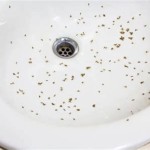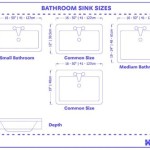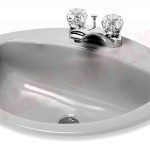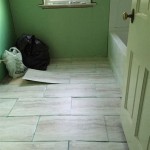How To Install Laminate Flooring In A Small Bathroom
Installing laminate flooring in a small bathroom can be a cost-effective and visually appealing alternative to tile or vinyl. While bathrooms present unique challenges due to moisture, careful preparation and proper installation techniques can result in a durable and attractive floor. This article provides a comprehensive guide to installing laminate flooring in a small bathroom, covering essential steps from preparation to finishing touches.
Key Point 1: Preparation and Assessment
Proper preparation is crucial for a successful laminate flooring installation, especially in a moisture-prone environment like a bathroom. This phase includes assessing the existing floor, selecting suitable laminate, and gathering the necessary tools and materials.
Assessing the Existing Subfloor: The existing subfloor must be structurally sound, level, and clean. Inspect for any signs of damage, such as water stains, rot, or mold. Repair any damaged areas before starting the installation. Common subfloor materials include plywood or concrete. If the subfloor is uneven, use a self-leveling compound to create a smooth surface. Ensure the subfloor is completely dry before proceeding, as moisture can lead to warping and other issues with the laminate flooring. Use a moisture meter to verify the moisture content is within the laminate manufacturer's specifications.
Selecting the Right Laminate: Choose a laminate flooring specifically designed for bathroom use. Look for products labeled as water-resistant or waterproof. These laminates often have a tighter locking system and a more durable wear layer to withstand moisture and foot traffic. Consider the thickness of the laminate, as thicker planks tend to be more stable and resistant to water damage. Read the manufacturer's specifications carefully to ensure the laminate is suitable for bathroom environments. Some laminates also feature antimicrobial coatings designed to inhibit mold and mildew growth.
Gathering Tools and Materials: Assemble all necessary tools and materials before starting the installation. This includes:
- Laminate flooring planks
- Underlayment (moisture barrier)
- Measuring tape
- Pencil
- Circular saw or laminate cutter
- Tapping block
- Pull bar
- Hammer
- Spacers
- Moisture meter
- Self-leveling compound (if needed)
- Silicone sealant
- Safety glasses
- Dust mask
Acclimatization: Allow the laminate flooring to acclimatize to the bathroom environment for at least 48 hours before installation. This allows the planks to adjust to the temperature and humidity levels, minimizing expansion and contraction after installation. Store the laminate in the bathroom, laid flat and in its original packaging, ensuring adequate airflow around the boxes.
Key Point 2: Installation Process
The installation process involves laying the underlayment, installing the laminate planks row by row, and cutting planks to fit around obstacles.
Installing the Underlayment: The underlayment serves as a moisture barrier and provides cushioning for the laminate flooring. Roll out the underlayment across the subfloor, ensuring it covers the entire area. Overlap the edges of the underlayment slightly and tape them together with moisture-resistant tape. Some underlayments come with an attached moisture barrier, eliminating the need for a separate layer. Pay close attention to the manufacturer's instructions for proper installation of the underlayment.
Laying the First Row: Begin installing the laminate flooring along the longest straight wall in the bathroom. Place spacers between the wall and the first row of planks to allow for expansion. The tongue side of the plank should face the wall. Connect the planks end-to-end using the locking mechanism. Ensure the planks are aligned properly and securely locked together. Use a tapping block and hammer to gently tap the planks together if necessary. Avoid excessive force, as this can damage the locking mechanism.
Continuing the Installation: Continue laying the laminate flooring row by row, staggering the seams to create a more visually appealing and structurally sound floor. Staggering the seams also helps to distribute weight evenly and reduce the risk of warping. Use a random pattern to avoid repeating the same seam layout. When connecting new planks to the previous row, angle the plank into the locking mechanism and then press down until it clicks into place. Use a pull bar to tighten the planks in tight spaces, such as near walls or pipes.
Cutting Planks: When reaching walls or obstacles, measure and cut the laminate planks to fit. Use a circular saw or laminate cutter to make precise cuts. A laminate cutter is generally cleaner and produces less dust than a circular saw. When cutting around pipes or other irregular shapes, use a jigsaw or coping saw to create the necessary cutouts. Ensure the cutouts are slightly larger than the diameter of the pipe to allow for expansion.
Addressing Door Jambs and Trim: Under cut door jambs and trim to allow the laminate flooring to slide underneath. Use a jamb saw or oscillating multi-tool to make these cuts. The height of the cut should match the thickness of the laminate flooring plus the underlayment. This creates a clean and professional finish.
Key Point 3: Finishing and Sealing
Proper finishing and sealing are essential to protect the laminate flooring from moisture and ensure its longevity in a bathroom environment.
Removing Spacers: Once the entire floor is installed, remove the spacers from around the perimeter of the room. These spacers provided the necessary expansion gap to prevent buckling and warping.
Installing Baseboards and Trim: Install baseboards or quarter-round trim around the perimeter of the room to cover the expansion gap and provide a finished look. Attach the trim to the wall, not the flooring, to allow the floor to expand and contract freely. Use finishing nails or construction adhesive to secure the trim in place. Caulk the trim to the wall to create a seamless transition.
Sealing Around Perimeter: Apply a bead of silicone sealant around the perimeter of the room, where the flooring meets the walls, toilet, and other fixtures. This sealant will prevent water from seeping underneath the flooring and causing damage. Use a high-quality, mildew-resistant silicone sealant specifically designed for bathroom use. Smooth the sealant with a wet finger or a sealant smoothing tool for a clean and professional finish. Pay close attention to sealing around the toilet flange, as this is a common area for water leaks.
Cleaning and Maintenance: Clean the laminate flooring with a damp mop and a mild detergent specifically designed for laminate floors. Avoid using excessive water, as this can damage the flooring. Wipe up spills immediately to prevent staining. Use mats or rugs in high-traffic areas to protect the flooring from scratches and wear. Avoid using abrasive cleaners or scouring pads, as these can damage the wear layer of the laminate.
Addressing Specific Bathroom Fixtures: When installing laminate around the toilet, ensure a proper seal is achieved. Use a wax ring to seal the toilet to the flange, and then apply silicone sealant around the base of the toilet where it meets the flooring. For vanities, consider installing the laminate flooring underneath the vanity to create a seamless look. If the vanity is already installed, cut the laminate to fit around the base of the vanity and seal the edges with silicone sealant.
Dealing with Expansion and Contraction: Laminate flooring will expand and contract with changes in temperature and humidity. The expansion gap around the perimeter of the room allows the flooring to move freely without buckling or cracking. Monitor the flooring for any signs of excessive expansion or contraction. If you notice any issues, consult with a flooring professional.
Ventilation: Proper ventilation is crucial in a bathroom to prevent moisture buildup and protect the laminate flooring. Install a bathroom exhaust fan to remove excess moisture after showers and baths. Ensure the exhaust fan is properly sized for the size of the bathroom. Keep the bathroom door open whenever possible to allow for air circulation.
By following these detailed steps, homeowners can successfully install laminate flooring in a small bathroom, creating a durable and attractive floor that will last for years. Remember to prioritize proper preparation, accurate installation techniques, and thorough sealing to protect the flooring from moisture and ensure its longevity.

How To Install Vinyl Plank Flooring In A Bathroom Fixthisbuildthat

How To Install Vinyl Plank Flooring In A Bathroom Fixthisbuildthat

How To Install Vinyl Plank Flooring In A Bathroom

How To Install Waterproof Laminate Flooring Twenty Oak

How To Install Vinyl Plank Flooring In A Bathroom Fixthisbuildthat

Installing Vinyl Plank Flooring Lifeproof Waterproof Rigid Core Sustain My Craft Habit

How To Install Vinyl Plank Flooring In A Bathroom Fixthisbuildthat

Installing Vinyl Plank Flooring Lifeproof Waterproof Rigid Core Sustain My Craft Habit

Small Bathroom Ideas To Make Your Efficient

How To Install Vinyl Plank Flooring In A Bathroom
Related Posts







